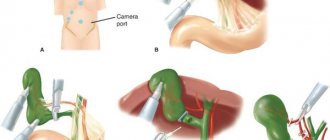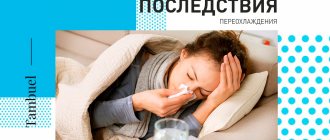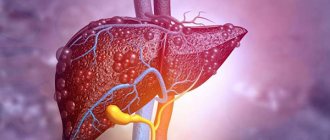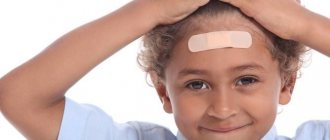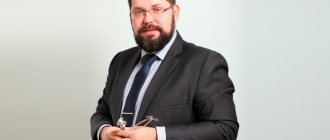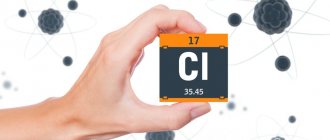Acute pancreatitis is a dangerous pathology that is life-threatening. The disease develops against the background of exacerbation of the pancreas. During an attack, severe pain is noted. It cannot always be relieved with medications, so urgent surgical treatment is required.
Forms of pancreatitis
Acute – characterized by acute girdling pain in the upper abdomen. Pain often appears after eating fatty foods or alcohol. Unpleasant sensations can be either barely noticeable or unbearable, radiating to the scapula or sternum. Nausea, vomiting, and stool disturbances are observed. Due to the obstructed flow of bile, the skin takes on a yellowish color.
Chronic - the main localization of pain is on the upper part of the abdominal wall with irradiation to the back, chest (left side), lower abdomen. Unpleasant sensations occur after eating heavy fatty foods, alcoholic drinks, and constant stress.
The development of chronic pancreatitis is characterized by nausea, loss of appetite, bloating, bowel dysfunction, and sometimes vomiting.
The chronic form of the pathology differs from the acute form by periods of remission and exacerbation. As the disease progresses, periods of exacerbation become more frequent; intestinal disorders, disturbances in normal digestion, and weight loss are possible.
Chronic pancreatitis often causes complications (stomach bleeding, cancer, cysts and abscesses, liver damage, diabetes mellitus, enterocolitis). That is why you need to take the disease seriously and, at the slightest suspicion of the development of inflammation, consult a doctor.
What is pancreatic necrosis?
The pancreas produces so-called pancreatic enzymes, which are normally involved in the digestion of food and the breakdown of proteins. If the pancreas becomes inflamed, the mechanism for protecting its own tissues from the destructive effects of secreted enzymes may be disrupted. The gland begins to deteriorate, which becomes the cause of pancreatic necrosis. We can say that with pancreatic necrosis, the gland gradually digests itself, its individual sections become necrotic, that is, they die. If the disease is not treated in time, areas of dead cells appear on the pancreas. The development of an abscess, which threatens the patient’s life, is possible.
Reasons for the development of pancreatitis
The disease develops due to damage to pancreatic tissue. This happens for the following reasons:
- alcohol and tobacco abuse
- abdominal trauma, surgery
- uncontrolled and long-term use of medications: antibiotics, hormonal drugs, corticosteroids, some diuretics
- intoxication with food products, chemicals
- genetic predisposition
- improper diet with a predominance of spicy and fatty foods and long breaks between meals
Diet
Pancreatitis requires a diet, and pancreatic necrosis of the pancreas requires an even more strict diet.
If surgery is indicated, then a few days before and a few days after it, the patient is transferred to clinical nutrition: intravenous or tube feeding. This is necessary to reduce enzyme activity as much as possible. At the same time, patients receive food enriched with proteins, vitamins and antioxidants.
After recovery, the patient will have to go on a strict diet forever. Alcohol, fatty, fried, smoked, spicy, sweet, canned food, too cold or too hot food are prohibited.
Symptoms of pancreatitis
Manifestations of pathology vary depending on the form - acute or chronic pancreatitis. In acute pancreatitis the following are observed:
- The pain is intense, constant, the nature of the pain is described by patients as cutting, dull.
- High body temperature, high or low blood pressure - the patient’s well-being quickly deteriorates due to the rapid development of the inflammatory process.
- Pale or yellowish complexion.
- Nausea and vomiting - dry mouth and a white coating appear, attacks of vomiting do not bring relief. The most correct step at this moment is to fast; any food intake can only worsen the situation.
- Diarrhea or constipation - stool in acute pancreatitis is most often foamy, often with a foul odor, with particles of undigested food. On the contrary, there are constipation, bloating, and hardening of the abdominal muscles, which may be the very first signal of an acute attack of pancreatitis.
- Bloating – the stomach and intestines do not contract during an attack.
- Shortness of breath - appears due to loss of electrolytes during vomiting.
Chronic pancreatitis is characterized by the following symptoms:
- Abdominal pain - may be girdling or have a clear localization radiating to the back. Appears after eating.
- Intoxication of the body - general weakness, loss of appetite, tachycardia, increased body temperature, and decreased blood pressure appear.
- Endocrine disorders - ketoacidosis, diabetes mellitus, tendency to hypoglycemia. Bright red spots may also appear in the abdomen, back, and chest, which do not disappear with pressure.
With a long course of the disease, the patient gradually develops anemia, weight loss, dry skin, brittle hair and nails, symptoms of vitamin deficiency, and increased fatigue.
Severity
Acute pancreatitis, the treatment of which is very difficult, can occur in various forms. The disease is classified depending on the severity:
- The mild form is characterized by the fact that the organ continues to function with minimal impairment. In this case, during instrumental examinations, slight swelling is detected.
- The average form causes complications of a necrotic nature. Against the background of organ failure, malfunctions occur in the functioning of other systems in the human body.
- The severe form is characterized by destruction by a strong inflammatory process, which often leads to purulent infected tissue necrosis. This can damage nearby organs.
First aid for an attack of pancreatitis
To reduce pain, you can use a heating pad filled with cold water. It needs to be applied to the abdominal area, namely to the epigastric region (the area under the xiphoid process, corresponding to the projection of the stomach onto the anterior abdominal wall). This allows you to reduce the intensity of pain, slightly reduce swelling and inflammation.
The patient must comply with the hospital regime. This will reduce blood flow to the organ, and therefore reduce inflammation.
Eating is prohibited. The digestion process can cause more severe pain, nausea and vomiting. And the diet will reduce the production of enzymes that increase the inflammatory response and pain. You need to fast for 3 days. You can drink clean water without gases.
It is imperative to call a doctor for an examination, even if the patient is not exactly sure that this is an attack of acute pancreatitis. As we already know, this pathology can subside and then rapidly recur. At this time, you can take a painkiller to reduce discomfort.
Diagnosis of the disease at the private medical clinic “Medunion”
Diagnosing this disease is not difficult, since the first signs speak for themselves. However, in order to prescribe adequate treatment, it is necessary to determine the form of the disease. To do this, the doctor performs laparoscopy - a method that allows you to examine the abdominal cavity from the inside using a special instrument.
If acute pancreatitis is suspected, laboratory tests are performed:
- General blood analysis
- Blood chemistry
- Analysis of urine
- Stool analysis
- Ultrasound, MRI or radiography of the abdominal organs
- Computed tomography according to indications
In the chronic form, the same studies are carried out, but it is better to take tests during the period of exacerbation of the disease.
For what reasons can pancreatic necrosis develop?
Pancreatic necrosis develops for the same reasons as acute pancreatitis. People who regularly break their diet are considered to be at risk. For example, they eat a lot of fried and spicy foods, and also abuse alcoholic beverages. In particular, many people suffering from alcoholism are at risk of developing chronic pancreatitis, which will ultimately be complicated by destruction of the pancreas, that is, pancreatic necrosis.
A provoking factor for the development of the disease is the consumption of alcohol or, in more rare cases, fatty foods. This is due to the fact that alcohol provokes increased secretion of pancreatic hormones. The pressure in the ducts of the organ increases, which provokes tissue swelling and destruction. As a result, the enzymes secreted by the gland are activated without leaving the organ, which leads to self-digestion of the pancreas.
Destroyed tissues enter the blood, causing the patient to develop symptoms of intoxication. The liver, heart and kidneys suffer from breakdown products. Encephalopathy often occurs as a complication of pancreatic necrosis.
Treatment of acute pancreatitis
If acute pancreatitis is detected, the patient should be hospitalized immediately. Treatment should take place in a hospital setting, as this condition is very dangerous.
To relieve pain, antispasmodics are taken; in difficult cases, the contents of the stomach are pumped out to relieve the load on the gland.
In case of exacerbation of pancreatitis, patients require hospitalization with daily monitoring of blood parameters, water balance, leukocyte count, and enzyme levels in the blood serum during the first week. In the first 1–3 days, fasting and taking alkaline solutions every 2 hours are recommended.
During an exacerbation of chronic pancreatitis, the patient is shown therapy similar to the acute process. The patient must follow a diet throughout his life and take drugs from the group of antispasmodics and drugs that normalize the secretory function of the organ.
The most important thing in the chronic form of the disease is to maintain a diet that involves excluding fatty and fried foods from the diet. At the slightest violation of the regimen, the patient may experience discomfort and nausea. For intense pain, the doctor prescribes antispasmodics. Antisecretory therapy can be used for a short course.
Treatment with Papaverine
Papaverine is a drug effective in the treatment of cholecystitis.
Papaverine belongs to the category of myotropic antispasmodic pharmaceutical drugs.
If you take a traditional medicine in a large dose, this will lead to a decrease in the excitability of the heart muscle and a slowdown in intracardiac conduction.
If a patient experiences vascular spasms in the brain, endarteritis, or pyloric spasm, then he is prescribed this traditional medication. The pharmaceutical medicine is highly effective in the treatment of angina, cholecystitis, and spastic colitis.
Diet for pancreatitis
For any form of the disease, the patient is prescribed a strict diet “Table No. 5p”, according to which it is forbidden to eat spicy and fried foods. All dishes are steamed, boiled or baked. Alcohol and smoking are also prohibited.
It is also necessary to limit salt intake and eat small portions 6 times a day. Dishes should always be served warm. It is necessary to exclude all products with a high content of extractives or essential oils (fish, meat broths, cocoa, coffee, etc.), fresh berries, vegetables, herbs, fruits, sour juices, carbonated drinks, marinades.
Application of No-shpa
No-shpa - the drug has an antispasmodic effect.
In acute pancreatitis, patients experience severe pain that must be eliminated. For this purpose, No-shpa is used, which have a pronounced therapeutic effect.
No-spa has a pronounced antispasmodic effect. The use of traditional medicine is carried out if the patient experiences spasms in the intestines or stomach.
Also indications for the use of pharmaceutical medicine are urolithiasis and cholelithiasis. Doctors prescribe pharmaceutical medicine to patients diagnosed with angina or spasmodic constipation.
The traditional medication is taken orally 2 to 3 times a day. A single dose of the drug ranges from 0.04 to 0.08 grams. You can also administer a two percent solution of the drug intravenously at 2-4 milligrams. If the patient has obliterating endarteritis, then the traditional medication must be injected into the artery.
Despite the high effectiveness of No-shpa, it can cause side effects if taken incorrectly. In most cases, patients complain of dizziness and rapid heartbeat.
In some patients, undesirable effects manifest themselves in the form of constipation, increased sweating, and a feeling of heat. Taking pharmaceutical medications can lead to allergic dermatitis.
No-spa is a highly effective medicine that fully copes with spasms in acute pancreatitis.
